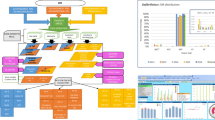Abstract
This paper presents a methodological tool which provides to the aeronautical designer a vision for considering the human factors in the aircraft design, focused on maintainability. The main goal of this guideline tool is to orient the engineers to design a product that makes the maintenance tasks easier for people. The guideline comprises a set of tables to drive the engineers for a better evaluation of the design aimed to human factors during the maintenance. It aims at improvements in the technical services to make the maintenance easier with an ergonomic condition. A case study is presented to validate the advantages and benefits achieved when the proposed tool is used.












Similar content being viewed by others
References
Tiburtino EB (2012) A utilização dos conceitos de humans factors model e design for human factors no projeto aeronáutico. Uma abordagem voltada à manutenção. 105 f. Dissertação (Mestrado)–EESC/USP, São Carlos
Bureau of Air Safety Investigation (1994) Human factors in aircraft maintenance: a preliminary information paper. Australia
Ferreyra AM, e Del Valle A (2000) Medio ambiente laboral de la tripulación deaeronaves. Salud Ocup. 18(76):22–27
Palma A (2002) Ciência pós-normal, saúde e riscos dos aeronautas: a incorporação da vulnerabilidade. Rio de Janeiro Tese de Doutorado–Escola Nacional de Saúde Pública, Fundação Oswaldo Cruz. p 255
DAC–Departamento de Aviação Civil (2004) Treinamento em gerenciamento de recursos de equipe. Simpósio de Gerenciamento de Recursos de Equipe. Rio de Janeiro
FAA–Federal Aviation Agency (2002). Human Factors in aviation maintenance. Phase on progress report, DOT/FAA/AM-91/16. Washington, D.C: Office of aviation Medicine
Majoros A (1992) Aircraft design for maintainability with future human models. In: Proceedings of the sixth meeting on human factors issues in aircraft maintenance and inspection
ICAO manual (2010). Human factors in aircraft maintenance and inspection. Aviatioknowledge. http://aviationknowledge.wikidot.com/aviation:icao:human-factors-in-aircraft-maintenance-inspecti
ATSB Transport Safety Report (2008). An overview of human factors in aviation maintenance. Aviat Res Anal. AR-2008-055
McDaniel JW, Askren WB (1985) Computer-aided design models to support ergonomics. Wright-Patterson Air Force Base, Ohio: Harry G. Armstrong Aerospace Medical Research Laboratory
Aris RB (2006) Maintenance factors in building design. Thesis of Master Degree. Civil Engineering. Malaysia University of Technology
Block J et al. (2008) Evaluation of preventive maintenance task intervals using field data from a complete life cycle. In: IEEE Aerospace Conference Proceedings
Bralla JG (1996) Design for excellence. McGraw-Hill, New York, p 327
Martins PG, Laugeni FP (2010) Administração da Produção. Editora Saraiva. Brazil
Wilson RM (2008) IET professional development course on electric traction systems. pp 363–385
Johnson WB, Maddox ME (2007) A PEAR shaped model for better human factors. CAT Magazine–Civil Aviation Training, n. 2, pp 20–21
Rashik HSJ (2010) Human factors effects in helicopter maintenance: proactive monitoring and controlling techniques. Cranfield University. School of Engineering
Yan J (2014) Identifying opportunities of tracking major human factors risks through flight data monitoring. Thesis of master of applied science in systems design engineering. University of Waterloo
ICAO–International Civil Aviation Organization (2003) Human factors guidelines for aircraft maintenance manual (Doc 9824). Montreal, Canada. www.icao.int/ANB/humanfactors/Documents.html
Shappell S, Wiegmann D (2004) The human factors analysis and classification system (HFACS). Approach
Hall JG, Silva A (2008) A conceptual model for the analysis of mishaps in human operated safety-critical systems. Saf Sci 46:22–37
Bellamy LJ, Geyer TAW, Wilkinson J (2007) Development of a functional model which integrates human factors, safety management systems and wider organizational issues. Saf Sci. doi:10.1016/j.ssci.2006.08.019
Truitt TR, Ahlstrom V (2001) Development of a generic GMCC simulator. Report No. DOT/FAA/CT-TN02/04. William J. Hughes Technical Center. FAA. Atlantic City International Airport, NJ 08405. US
Leach H (2005). Maintenance error prediction modelling. Thesis (Beng. Hon). Faculty of technology, School of Engineering, Kingston University
Drury CG, Prabhu P (1996) Information requirements of aircraft inspection: framework and analysis. Int J Hum Comp Stud 45:679–695
McFadden KL, Towell ER (1999) Aviation human factors: a framework for the new millennium. J Air Transp Manag 5:177–184
Fujita Y, Hollnagel E (2004) Failures without errors: quantification of context in HRA. Reliab Eng Syst Saf 83:145–151
Clarke DM (2005) Human redundancy in complex, hazardous systems: a theoretical framework. Saf Sci 43:655–677
Vinnem JE, Aven T (2006) Case illustration of a decision framework for health, environment, and safety management. In: Proc. IMechE Part O. J Risk Reliab. vol 220. pp 115–121. doi:10.1243/1748006XJRR12
Sadraey M (2008) Aircraft conceptual design. Chapter n 3, Daniel Webster College
Dassault systemes (2013) MECAmaster. Catia V5. http://www.plmmarketplace.com/software/mecamaster-assembly.html. Acesso em 19 de Outubro de 2013
Boothroyd G (2010) Product design for manufacture and assembly. 3rd edn. CRC Press. pp 709
Author information
Authors and Affiliations
Corresponding author
Additional information
Technical Editor: Fernando Antonio Forcellini.
Rights and permissions
About this article
Cite this article
Barbosa, G.F., Tiburtino, E.B. & Carvalho, J. A human factors methodology tailor-made for aeronautical design aimed to maintenance routines. J Braz. Soc. Mech. Sci. Eng. 39, 497–507 (2017). https://doi.org/10.1007/s40430-015-0382-9
Received:
Accepted:
Published:
Issue Date:
DOI: https://doi.org/10.1007/s40430-015-0382-9




